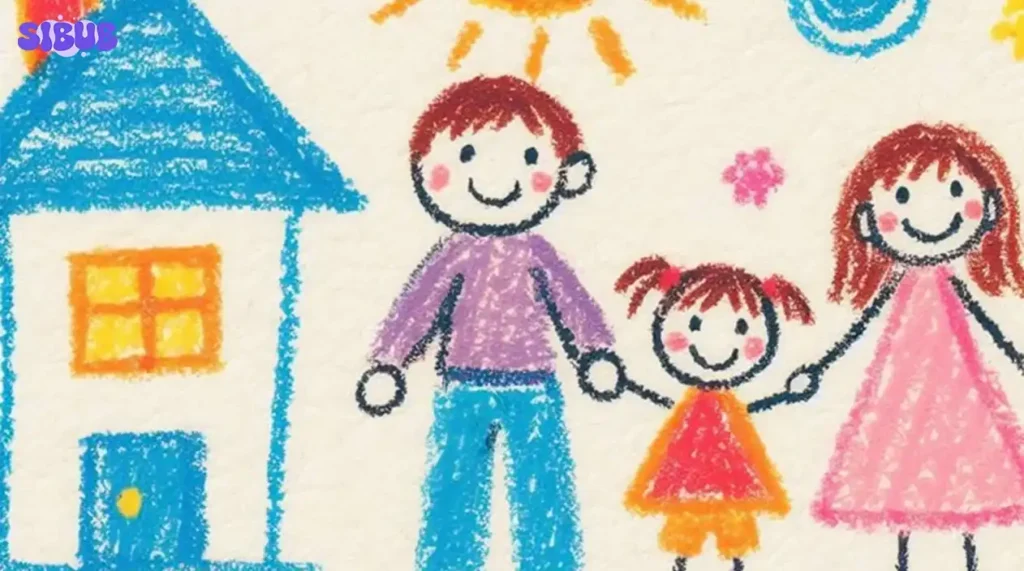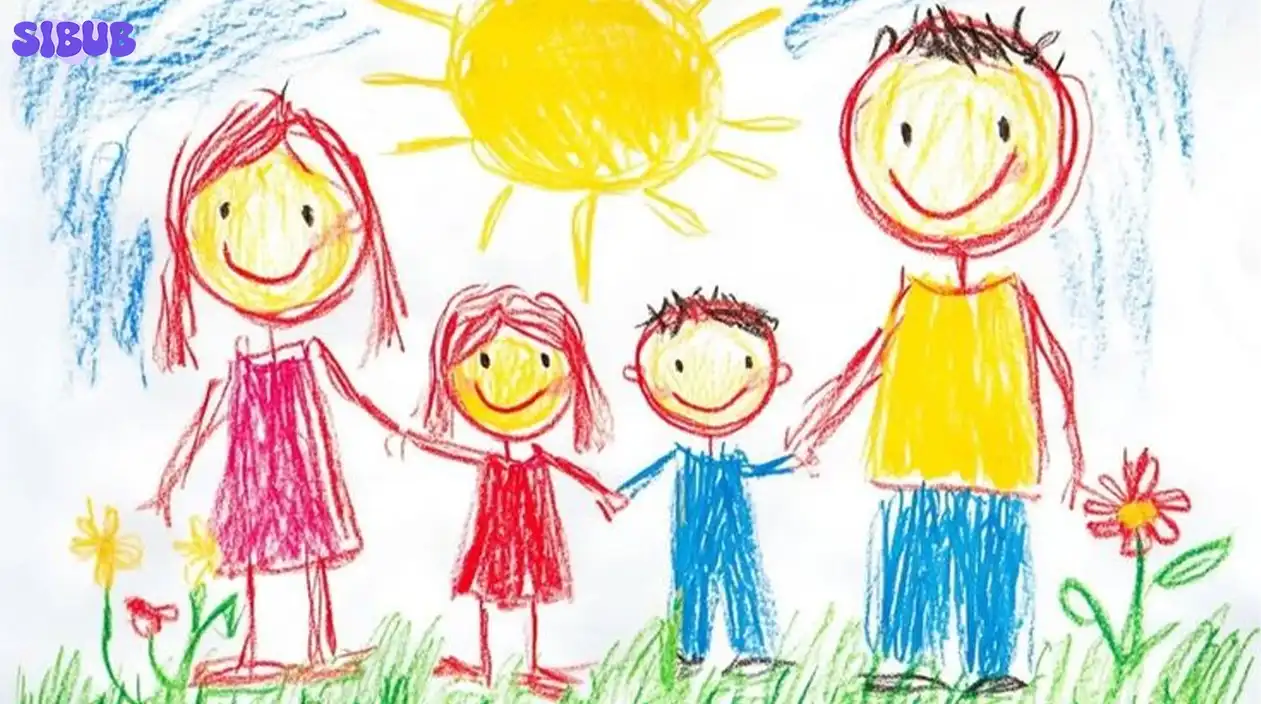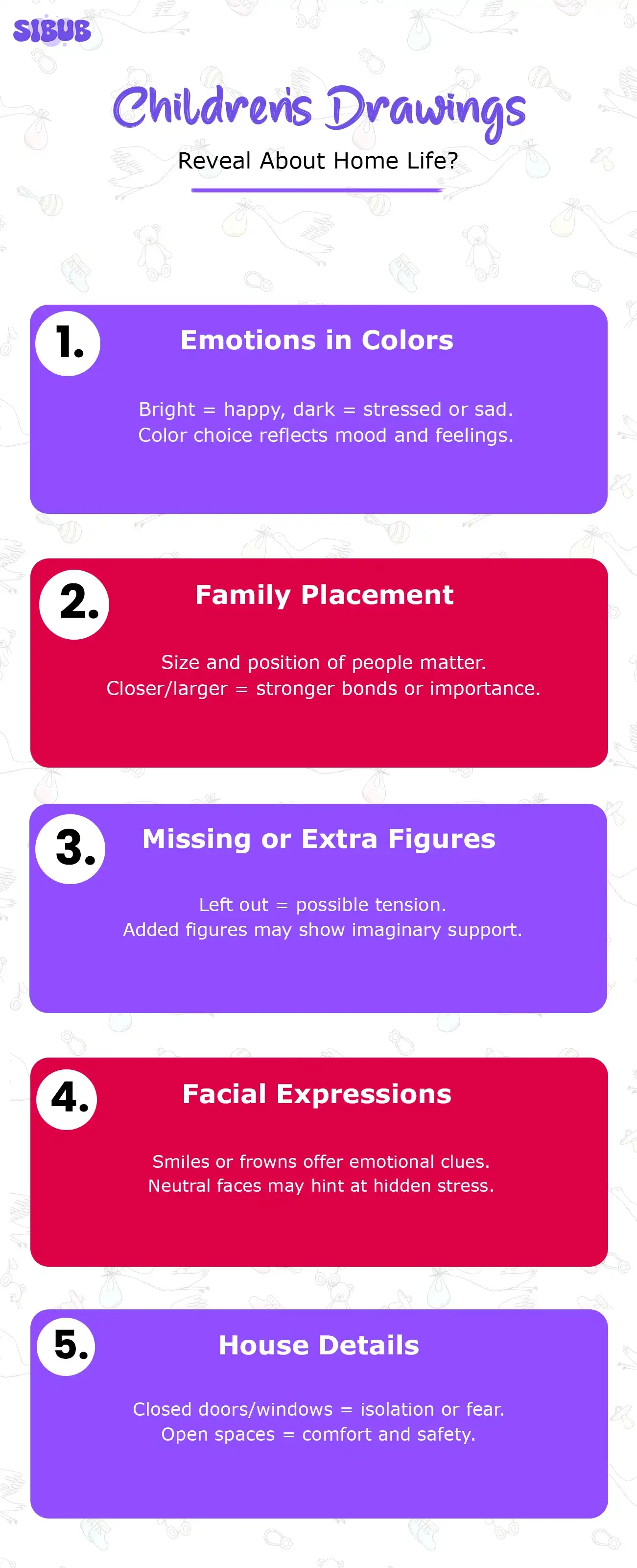Child drawing is more than just scribbles and stick figures. It’s a window into a child’s inner world; and often, into their life at home. Whether it’s a colorful family portrait or a crayon drawing of their room, kids say a lot through pictures, especially when they don’t yet have the words to explain how they feel.
In this blog, we’ll explore what children drawing pictures can reveal about their relationships, emotions, and home life. We’ll also look at how to understand child’s drawing of a family, what symbols to watch for, and why you should always ask your child to tell you about their drawing before jumping to conclusions.
Why Kids Draw: More Than Just Art
Kids love to draw. But childhood drawings aren’t only about creativity. Drawing is one of the earliest ways children learn to communicate.
Before kids develop strong verbal skills, they use drawing as a language of their own. Through child drawing, they share stories, express feelings, and show us how they see the world, especially their home and family.

Discover: 9 Printable Feelings Chart for Kids To Support Emotional Growth
Drawing Is a Communication Tool
From a young age, drawing is one of the easiest ways for children to express themselves.
- They draw what they know.
- They draw what they see.
- And most importantly, they draw what they feel.
According to researchers, drawing helps kids develop emotional awareness, motor skills, perception, and even social understanding. It allows them to connect with the people around them, including family.
Children Drawing Pictures of Their Family: What It Says
One of the most common things a child draws is their family. A child’s drawing of a family can tell you a lot: how the child feels about themselves, how close they feel to different family members, and even if something might be bothering them.
Here are a few things to look at in a child family drawing interpretation:
1. Who Is in the Picture?
Are all family members shown? Are any missing?
- A missing figure might show distance or tension.
- Extra figures could mean close family friends or even imaginary comfort figures.
2. Size and Placement
Size often reflects importance. If Mom is big and in the middle, that’s a sign she’s central in the child’s life. If the child’s drawing shows a tiny Dad off to the side, it could suggest the child feels distant from him.
3. Facial Expressions and Emotions
Are the characters smiling? Frowning? Do they have eyes?
Large, expressive eyes might show a child feels watched or anxious. Missing eyes can reflect discomfort or fear.

Explore: Molluscum Contagiosum Treatment for Children
Kids Draw Feelings Before They Understand Them
Children don’t always understand their emotions clearly. But their drawings often reveal their unconscious feelings. That’s why so many psychologists use child drawing as a projective tool to assess mental states.
For instance:
- Shading the entire body could mean anxiety.
- A head that’s too large might signal an inflated ego, or worry about thinking too much.
- Overly dark or heavy lines can show anger, sadness, or tension.
This doesn’t mean every detail in a drawing has a secret meaning, but patterns, especially repeated ones, can give parents clues.
What a Child’s Drawing of Family Can Reveal
Let’s focus specifically on what a child’s drawing of a family can tell us. Experts have studied this in many contexts, and there are some common things to look for:

Repeated Themes
If your child consistently draws themselves far away from the rest of the family, that might show they feel isolated or misunderstood.
Missing Parts
No hands? No mouth? This might reflect feelings of helplessness or being unable to speak freely.
Excessive Detail in Certain Areas
Over-emphasizing certain body parts (like teeth, hands, or necks) might point to deeper emotional signals. For example, large teeth may reflect anger or aggression.
Drawing Order
Kids usually draw the person they feel closest to first.
Gender Roles
Children often reflect social norms they observe. If the child’s drawing shows Mom cooking and Dad outside or working, it may reflect what they see in daily life.
Learn More: Top Benefits of Summer Camp for Kids
Development and Age: What to Expect from Drawings by 6-Year-Olds
Drawings by 6 year olds can be especially revealing. By this age, children typically:
- Include most body parts in drawings.
- Show some awareness of space and relationships.
- Start using symbols like hearts, suns, or houses.
This age is key for cognitive and emotional growth. Their child’s drawing may start to show more context, like their house, school, pets, or friends.
You may see:
- Bigger paper is used by more confident kids.
- Smaller paper picked by more reserved children.
- Bold colors or thick pencils are used by kids who are determined or energetic.
Let them choose their materials freely. Even the kind of paper and pencil they use says something about them.
Cultural and Environmental Influences in Childhood Drawings
Children don’t draw in a vacuum. What they see and experience daily shows up in their art.
For example:
- A child from a warm, loving home might use bright colors and draw everyone smiling.
- A child experiencing stress may show chaotic lines, missing people, or darker tones.
Family culture also plays a role. Kids mimic the values and relationships they observe. A child’s family drawing in one culture may focus more on community, while in another, it may show independence.

Real-Life Examples of Kids’ Drawings Telling Stories
Let’s say your child draws the house over and over, often without much else.
This is common in ages 6 to 7. The house symbolizes emotional security, stability, and comfort. If child drawing always includes home elements and warm colors, it can mean they feel safe.
But if those houses look broken, empty, or alone, it’s worth asking some gentle questions.
Another example: A child who repeatedly draws themselves much smaller than others might be feeling powerless, especially if there’s a change at home like divorce, moving, or new siblings.
Common Signs Parents Should Notice
Sometimes a child’s drawing raises red flags that something is wrong. Keep in mind:
One drawing alone doesn’t define a problem, but if patterns repeat or your child avoids drawing family altogether, you may want to explore it further.
Watch for:
- Figures that are always missing or erased.
- Repeated shading or crossed-out sections.
- Drawings are confined to a small corner of the page.
- Constantly drawing violent scenes or feeling unable to describe the picture.
Again, always talk with your child about the drawing. Ask simple questions like:
“Can you tell me about this picture?” “Who’s this person?” “How did you feel when you made this?”
How to Talk to Your Child About Their Drawings
Here’s how to approach your child’s art gently and supportively:
- Be curious, not critical.
- Don’t over-analyze one picture.
- Let them explain it in their own words.
- Praise the effort, not just the final product.
Avoid interpreting too much without understanding context. For example, a dark sky doesn’t always mean sadness, maybe they just love space!
Why Encouraging Drawing at Home Matters
When parents value their child’s drawings, they send a strong message: Your feelings matter. Your stories matter.
Displaying childhood drawings at home:
- Builds confidence.
- Strengthens parent-child bonds.
- Encourages emotional sharing.
It also gives you insight into what’s going on in their little world, and what they might not be saying out loud.
Final Thoughts: One Drawing Can Say a Lot
A single child drawing can hold more information than you might expect. From how they see family relationships to their sense of self-worth, every line and color carries meaning.
So next time your child hands you a drawing, don’t just smile and hang it on the fridge. Ask them about it. Dive in. You might discover something beautiful or something important.
And if your gut tells you something’s off in your child’s drawing of a family, don’t ignore it. Trust your instincts and, if needed, speak to a child psychologist or counselor.
Drawings are more than art. They’re a voice.
Key Takeaways for Parents
- Drawing is a powerful tool for kids to express what they feel and how they live.
- A child’s drawing of a family often reflects emotional bonds, self-image, and home dynamics.
- Repetition, missing elements, or changes in tone may indicate shifts in emotions or experiences.
- Drawings by 6 year olds start to show more symbols and structure, looking at both content and style.
- Let children explain their art in their own words. It deepens the connection and gives you insight into their mind.
